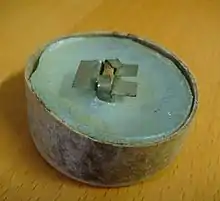Hindenburg light
The Hindenburg light or Hindenburglicht, was a source of lighting used in the trenches of the First World War, named after the Commander-in-Chief of the German army in World War I, Paul von Hindenburg. It was also used in World War II in air raid shelters (Luftschutzkeller) or during power cuts, and mandated black outs as emergency lighting.[1] It was a flat bowl approximately 5–8 cm (2.0–3.1 in) diameter and 1–1.5 cm (0.39–0.59 in) deep. It resembles the cover of Mason jar lid (Schraubglasdeckel) and was made from pasteboard. This flat bowl was filled with a wax-like fat (tallow). A short wick (Docht) in the center was lit and burned for some hours. A later model of the Hindenburglicht was a "tin can (Dosenlicht) lamp." Here, a wax-filled tin can have two wicks in a holder. If both wicks are lit, a common, broad flame (zungenfoermige Flamme) results.

It is also mentioned in the novels Stalingrad and Berlin by Theodore Plievier, as used on the Eastern Front and in air raid shelters respectively. Also it is mentioned in Wheels of Terror by Sven Hassel and In Deadly Combat A German Soldier's Memoir of the Eastern Front by Gottlob Herbert Biedermann.
See also
References
- Eberhard Von Breitenbuch (2011). Erinnerungen eines Reserveoffiziers: 1939 - 1945 (in German). BoD – Books on Demand. pp. 14–. ISBN 978-3-8391-7025-0. Retrieved 17 August 2013.
je, die beiden Ziegenböcke, die unter erstauntem Blinzeln an Rossmanns Feldbluse knabberten. Nachdem das Streichholz erloschen, suchte Rossmann in seinem Spind fieberhaft nach einem Hindenburglicht, da er seine Taschenlampe ...